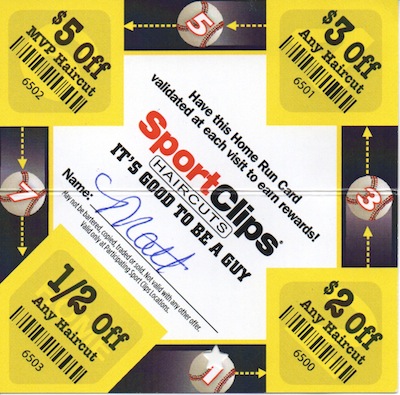Engagement
Five Ways to Boost Your Rewards Program
Your previous customers will be your best future customers. They are the most likely to trust you, the most likely to buy from you, and, usually, much cheaper to (re)acquire than brand new customers.
A rewards program is a common way of catering to your previous customers, giving them a reason to come back and bringing your brand back to the forefront of their minds. This is true for both brick-and-mortar and ecommerce shops. But in order for a program to work, people have to actually participate in it, so if you’re going to invest in a loyalty program of some kind, don’t be boring.
And don’t be sleazy. These days, people are more cynical than ever. They know that most loyalty programs are really a way to get access to their personal data so they can get bombarded with marketing. You want to cut through that noise. For someone who has already purchased something from you, how do you craft a rewards program thats so appealing and enticing that it melts the cynicism away like a snowman on the equator?
Here are five ways to help make your rewards program more engaging.
Provide Pit Stops on the Way to Larger Rewards
Many rewards programs come in the form of prizes at the end of a long marathon. Buy nine combo meals and the tenth is free. Accumulate enough points, and you get a $5 gift card. These are fine, and they can work. I’ve collected many free combo meals, and I appreciate them. However, I would have purchased those other nine meals whether there was a reward at the end or not.
If I think the food or service is mediocre, is more of the same mediocrity really going to be a motivating factor for me? You have one shot to get my loyalty. That’s it. All or nothing. If I catch you on an off-day, goodbye forever. The promise of free stuff several months from now isn’t going to keep me from forgetting about you.
A loyalty program should give you more chances to gain a customer’s loyalty, and not just assume the presence of that loyalty as if it’s your company’s God-given birthright. If a customer doesn’t want the reward at end, why would they jump through the hoops?
So turn a rewards program from a long marathon to a series of sprints instead. You can still build up to great rewards at the end, but provide more immediate rewards. Offer some pit stops.
Sport Clips does a great job with this. Here is their rewards card:

Sports Clips offers incremental rewards to build momentum
They do at least three things of note.
- They ensure you get something on just your second visit. The faster you can get a first-time customer to buy from you a second time, the closer you are to becoming a habit, and Sports Clips obviously wants to get people through their doors a second time.
- They offer a reward every other visit, each one getting progressively better. No need to slog through nine visits to get your free carrot. Sure, the $2 and $3 off rewards aren’t anything shout from the rooftops about, but they’re enough that it feels like a waste not to take advantage of them. And then I’m that much closer to the larger rewards. They encourage me to build momentum, rather than delaying gratification.
- They make the rewards large and obvious. That might be…well…obvious, but many I’ve seen almost seem ashamed of the prize, buried in small print. Like they think the journey is more important than the destination. Hint: it’s not.
For an inverse example, see the Papa Johns reward program. In order to earn a free pizza, you have to spend $125. And only online purchases count.
Use the Element of Surprise
Using surprise (in a good way) can exceed expectations and leave the customer delighted. There are a couple of ways to positively inject the unexpected.
Surprise Intervals for Rewards

What’s good enough for adorable puppies is good enough for you
There is a concept in behavioral analysis and conditioning called intermittent reinforcement. In general, reinforcement is a consequence that is intended to strengthen the behavior of an organism. Giving a dog a treat after they successfully obeyed your command is the obvious example, and usually you find discussion of reinforcement in the realm of animal training. But people are just as open to certain types of conditioning.
Intermittent reinforcement is where the subject gets what they want only some of the time. This is in contrast to:
- Continuous reinforcement – the subject always gets what they want after a behavior.
- Scheduled reinforcement – reinforcement follows a set schedule. For example, every five times the monkey pulls the lever, they get a reward. The Sports Clip example above is a type of scheduled reinforcement, offering something every other visit.
Why use a form of intermittent reinforcement? Studies have shown that organisms are more likely to repeat a behavior when they are only sometimes rewarded for it, when compared with continuous reinforcement. The psychology behind the slot machine is a prime example.
We are creatures of habit. One reason intermittent works so well is that it makes it hard to break a habit reinforced irregularly, since we become accustomed to intervals without a reward. We come to expect them, and just assume the reward will come next time. This works in our favor when talking about good habits. And certainly, you should strive to make sure that any interaction with your brand falls under the category of “good.”
How can all of this relate to your loyalty program? Randomize the timing within a small range of actions, so a customer gets something every one, two or three visits. The actual range is something to test for your own clientele. You don’t want to go too long before providing some type of reinforcement, especially early on in the funnel. But change it up. The McDonald’s Monopoly game is great example of this in action, where there is a 25% chance you are going to win something each time you play. Some kind of game is a good way implement this strategy.
You could also have a set schedule for rewards, but then also provide additional rewards randomly. This way customers know what to expect, but every once in a while they are delighted by something extra. This is a good way to get the best of both worlds.
When starting a new participant, however, you’ll want to give them a reward every visit for the first couple of times, so they get a taste for it.
Surprise and Out-of-the-Box Rewards

Surprises can help your rewards stand out
The other way to introduce surprise is to keep people guessing about what they might get. Zoe’s Kitchen does this well with their mobile app. You take a picture of your receipts, and sometimes it will pop up with a reward. You never know exactly what you might get. Sometimes it’s a free dessert, sometimes a free drink, and sometimes a valuable buy-one-get-one-free entree.
You do risk giving the customer something they don’t really want or care about, and you now have a customer who is relating dissatisfaction with your brand. I hinted at this in the previous point, but to lower the risk of this happening, it might be better to use surprise rewards on top of other transparent, and scheduled, rewards.
Have fun with it. These types of rewards can even be silly or ridiculous, depending on your brand image. One common trick for memorization is to associate what you want to remember with something completely off the wall. The same principle can apply to your company. Some examples:
- Invent or design a product (like a sandwich) and have it on the menu for a week.
- Get as much free candy as you can carry in one hand.
- Participation in a virtual scavenger hunt or trivia contest.
- Get your art featured on a special limited-edition t-shirt.
- Shoot the owner with a water gun for 30 seconds.
While only some of these could work with a ecommerce business, you can learn, tweak, and apply. This is where your entrepreneurial creativity should come in, informed by a deep knowledge of your customer’s motivations and mindset. This is also a good opportunity to partner with other businesses that are related to what you do.
Of course, very few people want zany antics from their financial institution, so be aware of how appropriate things are to your brand, and keep in mind why your customers came to you in the first place. That being said, even banks can have fun with marketing.
Make the First Interaction Easy – and Reward People For It
Genghis Grill, for their loyalty program, used to give you enough reward points to earn a free meal. All you had to do was take your new loyalty card home, type in the number online, and provide your name and email address. While that required some effort and isn’t frictionless, it was still easy, didn’t require a purchase, and the reward more than made up for any hassle. And they almost guaranteed that I would come in to one of their restaurants at least one more time.
Remember, an interaction doesn’t have to be a purchase. It doesn’t even have to be submitting some personal information. It can be as easy as a Facebook shout-out or a retweet, or answering a simple question that gives you valuable feedback.
Consider soliciting reviews of their experience or purchase and then reward them generously. You should be asking for customers to review your products anyway, adding to the social proof around your brand, so having it piggy-back on your reward program is a no-brainer.
Don’t Underestimate Paper
While mobile apps are all the rage these days, don’t underestimate the old fashioned, tried-and-true, paper card. It has numerous advantages, and any honest evaluation should take these into account when deciding how rewards are tracked.
- Frictionless sign up – no account needed to start. Just take a card.
- Frictionless progress – no account needed to track your progress. Everything you need is on the card.
- No equipment needed – those who don’t have a $600 pocket computer can still participate.
For an online only business, traditional loyalty punch cards aren’t possible or even desirable, but you can learn from their advantages and try to translate the underlying principles. Ask yourself some hard questions.
- Do you really need their name and phone number to get them started? If so, can it be collected at a later date, like when they are actually ready to collect a reward? Genghis Grill allows customers to accumulate points without any registration or information, and only absolutely requires it once you are ready to redeem a reward. That is a good pattern to follow.
- Do you have the infrastructure to analyze and act on large amounts of complex data, like historical buying habits? If not, do you really need any personal information for them to track their progress?
- Are you prepared to take advantage of the full capabilities and potential of a mobile app, or would it just be the digital version of a punch card?
The same ideas behind offering a guest checkout apply to an ecommerce rewards program, if your goal is maximum participation, and not just collection more personal data. Their progress can simply be included in each rewards email you send them, or part of an order status email.
Offer a VIP Status
Everyone wants to feel like they are special, and being part of an exclusive club helps foster this feeling. Offering members better rewards and special treatment is . If a customer knows they are going to get special treatment at your company, that makes it harder for them to jump to one of your competitors.
You can grant someone VIP status in two ways.
Charge For It
This is Amazon’s model with Amazon Prime. For $79, customer’s get free 2-day shipping, access to a streaming library, and various other benefits. How likely are Prime members to check Amazon first before making a purchase?
Sam’s Club and Costco are also good examples.
Based on Participation Itself
The more they buy and interact with your brand, the higher in status they climb. Airline miles are the classic example of this. Accumulate enough miles in a given year, and you get special status, entitling you to special lounges, free 1st-class upgrades, and other rewards.
Starbucks rewards is a good example of this on a small scale. They have three levels based on the amount of activity within a 12 month period. At the “Welcome” level, you get birthday treats and coupons. If you earn 5 stars in a year, you get placed in the “Green” level, earning you free in-store refills. If you earn 30 stars within a year, you are boosted to the “Gold” level, giving you more opportunities for free drinks, and a personalized gold card.
Using this method provides a great opportunity to inject some gamification into your program. Add public leaderboards. Provide badges, titles, or other personalized items based on progress. VIP status becomes more valuable if you can easily show off and brag about it.
Conclusion
A loyalty program can encourage previous customers to repeat. Some surveys show that as high as 82% of people say they are more likely to shop somewhere with a loyalty program, and once they buy into the system, they are more likely to offer repeat business.
How you offer rewards can fall flat, or help take your online business to the next level. Following some of the recommendations above can help ensure that customers show up to play, and return again and again.
Do you have a rewards program? Are there any tactics that helped you increase participation?